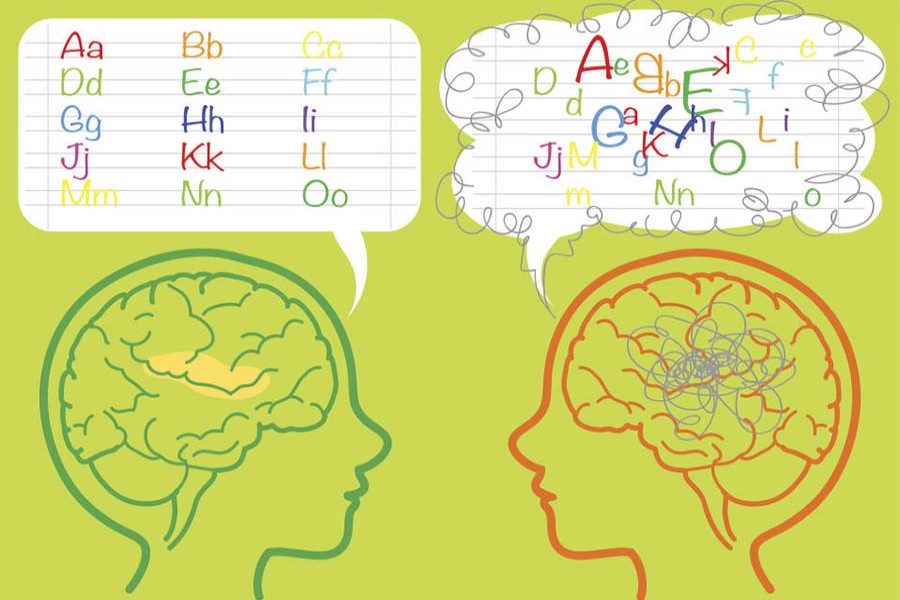Kashif Gauri is a child from Charkharpool in Dhaka city. He lives with his family. Like all the kids out there, he also likes to play around, watch television, engage in funny conversations. But somehow he fails to cheerfully do all those things a normal kid does everyday. He looks totally normal from the outside; however, things are not so from within him.
From childhood, Kashif had been consistently lagging behind his peers in academics. For his elder brother at his age, he was not so progressive or active. His parents had tried their best to improve his condition but to no avail. At the age of 8, his parents took him to a psychiatrist and discovered that Kashif wasn’t like a normal kid. He had dyslexia, a disease that is barely familiar to average people.
So, what is dyslexia? National Health Service UK defines it as a language learning disability, related to difficulties in reading and writing. People with dyslexia might have problems recognising letters and words, perceiving words and ideas, pronouncing and learning new words. They may struggle with rhyming, see letters in reverse, and can have problems in the general vocabulary. All these symptoms vary. It is a neurological condition that interferes with how someone learns. It has nothing to do with intelligence, motivation, or poor parenting. According to European Dyslexia Association (EDA), 9 to 12 per cent of the population worldwide can have dyslexia, and among them, 2 to 4 per cent can have serious effects.
Now the question is whether our parents are really aware of this disease that might be limiting their children’s capacity without their knowledge. The answer is no for the most of them. This is a problem with the whole society as we have a prone mentality to ignore mental problems i.e. depression, anxiety, etc. no matter how serious the condition is.
In 2015, a cross-sectional study by two Bangladeshi researchers was conducted on 133 students of Grade-4 of three primary schools in the Mohammadpur area to determine the prevalence of dyslexia among primary children. Surprisingly 9.02 per cent of the total samples were diagnosed with dyslexia. The biggest sorrow of this whole research was that all the kids were previously undiagnosed and till now have been tolerating the continuous unprecedented mental pressure. Both the parents and the teachers really didn’t have any idea about their condition. Rather it was found that most of the teachers lack the required qualifications and had mistreated many children due to their poor performance.
In European countries, for instance, Switzerland, dyslexic students are given longer time for their test, if needed they are even given breaks between exams; in Italy, they use an individualised educational plan for such kids and observe their progress frequently; in England, assessment test related to dyslexia are offered free of charge and if needed an alternative teaching method is adopted for them. But here in Bangladesh, children are not even getting diagnosed.
What needs to be done?
The first and foremost priority in Bangladesh regarding dyslexia should be to increase awareness. Schools and colleges should arrange weekly or monthly seminars where not only dyslexia but other mental health problems will be addressed. TV programmes, like talk shows, dramas, movies addressing such problems, can be made. The educational system for children with special needs should be improved. Teachers should be recruited after properly assessing their qualifications and ability to deal with children with certain disabilities. Necessary materials like audiobooks, individualised classrooms, training facilities to guide such children or people should be arranged.
Dyslexic people are not considered patients as dyslexia is not taken as an illness. They are not intellectually disabled. They are teachable but with alternative teaching methods. This thing will be much clearer if we all recall the famous Indian movie ‘Taare Zameen Par’ starring Aamir Khan. The boy Ishaan was able to prove his potential when some alternative methods were used for education by his teacher. The movie has clearly showcased how dyslexic people can overcome their difficulties if they are given genuine care and attention.
If proper methods are adopted, one’s dyslexia can evolve. When asked about the teaching methods available for dyslexic kids, Sabrena Akter, the managing director at Kiddle Rocks Ltd, a special children's school, said there are a number of educational interventions which can help children with their reading and writing. These interventions usually focus on phonological skills to help dyslexics identify and process sounds and words so that they can ultimately use those words to create complex sentences. The extent of this intervention varies, but it can be very effective at a young age. So she suggested every parent not to ignore any abnormality involving their children and provide them with necessary help as early as possible.
We live in a society where people have an unquenchable thirst for perfection. So when they see someone not fulfilling the so-called perfection criteria, they tend to tear him or her down to their ultimate breakdown. There are many dyslexic people in our country who really want to learn but end up giving it up with no support available to overcome their learning difficulties. Again, there are some people who don't even know about their condition and they are living their life considering themselves unworthy or incapable. But now it’s time for a change. Having dyslexia is nothing to be ashamed of. Dyslexic people are also part of the society and deserve help and care. And it is the responsibility of the society to create an environment where they would be able to say: “I will learn, instead of I can’t learn.”
Faizunnahar Fiza is a student of marketing at Dhaka University.


